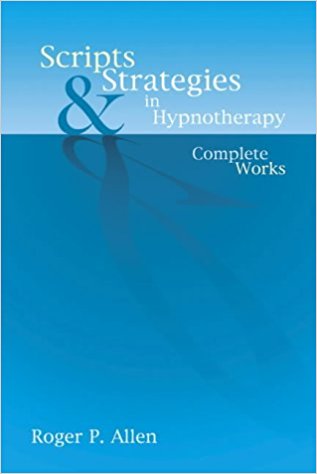Review Of Scripts And Strategies In Hypnotherapy…
I bought “Scripts And Strategies In Hypnotherapy” by Roger Allen many years ago while I was training to be a clinical hypnotherapist at the London College Of Clinical Hypnotherapy. It was recommended to our class by one of our teachers, Peter Mabbutt, who I noticed contributed a small testimonial/review on the back of the book. He basically said, and I agree, that this book is a useful addition for newly qualified hypnotherapists, and a source of inspiration for the more experienced.
This book is actually two books (volumes I and II) combined into one super script book, and is in a nice durable hard back format. It is well divided into sub categories to make what you are looking for very easy to find. It starts with inductions and deepeners, before delving into various different therapies. What sets this script book aside from most others is that it also includes a section ‘Therapy Strategies’, which shows various techniques such as ideomotor responses (I.M.R.’s), and parts therapy.
A little oversight I spotted in the introduction of the I.M.R. section was that Roger Allen stated that I.M.R.’s are used as it is widely believed that asking a client to talk during a session can ‘interfere with the depth of the trance’. Whilst this may be true, I.M.R.’s are far more useful than this. They allow a hypnotherapist a great opportunity to engage in a dialogue directly with the subconscious mind. This can be useful in many instances, especially asking it to make a change. I.M.R.’s are also a good tool to convince skeptics that hypnotherapy does indeed work, as they experience something very real happening. I.M.R.’s are also useful for communicating with people who have difficulty verbalizing their problems, and can even be used for “secret therapy” when a client does not wish to divulge their problems with the therapist.
In the parts therapy section, although it is described accurately how to use this technique, it doesn’t say when and why you would use it. Parts therapy is basically about resolving inner conflict. We have many roles in life, and it is almost like out subconscious has several personalities. A good clue when a client needs parts therapy is when they say something like, “A part of me wants to lose weight, but another part always sabotages my efforts.” Parts therapy aims to resolve this inner conflict of the different goals and aims in the different parts of our lives.
So although this book describes many techniques accurately and well, it sometimes fails to explain the context in which they would be used. Someone who had never met these techniques before could be left a little confused unless they did some additional research.
There is a really good script of sorts called “Weight – What I Tell ‘Em”. It is a condensed version of talks Roger does regarding weight loss. His reason for including it is to help you as the therapist to be able to talk about the subject of weight loss with some authority. If you ever were asked to do a talk on weight loss, or even if a client asked you about it, then it would be a good starting point to read this and then adapting it to suit your own style. You can also use this to gain inspiration about what to say and how to approach talking about other subjects within hypnotherapy.
There is also a short section that contains 3 ‘metaphors’ which are basically short therapeutic stories. The beauty of story telling is that you can talk about a fictional character, rather than the subject. This can help prevent their ego from blocking what is being said – after all it is not them you are talking about, just a fictional ‘character’!
This book also goes a little beyond the scope of hypnotherapy as it also includes 3 N.L.P techniques. These are the ‘Swish technique’ (for weight control), six step reframe, and anchoring.
Regardless of this good additional material, the main reason for buying this book is the collection of scripts that it contains. As well as the more staple therapies, such as weight loss, confidence, and smoking, it also contains some more unusual therapies, such as ‘Past Life Recall’, ‘Sports Performance’ and ‘Pass Your Driving test’.
The scripts are generally well written and they will provide a very useful addition to your therapeutic ‘toolbox’. If you don’t wish to use scripts verbatim, then at least you can look at Roger’s therapeutic strategies to get ideas for your own approaches. It’s always good to see how others approach their therapy. You can never stop learning. Roger also makes the good point that hypnosis scripts have “the added value of being carefully thought through with particular attention to semantics in order to exclude negative suggestion.” (Pg. 108)
One small problem I noticed was that sometimes Roger advises counting forward 1-2-3-4-5 to deepen the trance, and sometimes counting backwards 5-4-3-2-1. Some of his examples also show counting forward to reorient the client, and sometimes counting backward. It is better to choose one direction for deepening, and the opposite for reorienting. This avoids the potential for confusing the subject.
There is a very comprehensive section on smoking cessation, which is one of the most common treatments a hypnotherapist is asked for. As well as several different scripts and methods, there is also a questionnaire and ‘client education’. There is just about everything you need on smoking cessation.
I was slightly concerned that the book contains a script for ‘Sexual Assault’. Personally I do not treat patients for such matters as I firmly believe that such matters are best dealt with by specifically qualified medical professionals, councilors etc. I was also a little surprised that there was not at least some sort of warning to use this script with care.
In his scripts, Roger often uses a few methods to achieve the aim, which I am a big fan of doing in my own scripts. For instance in his ‘Confidence Building’ script, he starts off with quite direct suggestions, talking about not needing perfection in life, and illustrating that nothing and no one is perfect. In my experience people worrying about being perfect is one of the leading causes of a lack of confidence. Later in the script he guides the subject back to a time when they felt really confident. He then asks the subject to visualize these growing feelings of confidence as a white light encompasses them, growing and expanding. Using these two quite different approaches should greatly increase the chances of therapeutic success.
Most of the scripts in this book are relatively simple in nature. This is by no means a criticism. I firmly believe that over complicated therapy can just confuse the mind, not knowing what the aim of the session is. Throwing 20 different therapeutic methods into a script is no good in my eyes. I usually stick to 2 or 3 different approaches, and I also try to blend them together in some way so that they support and strengthen each other. Roger appears to have a similar approach to this. Perhaps without knowing it, maybe Roger’s scripts have influenced my own script writing style more than I realise, since I have owned this book since 2004.
I would have no hesitation whatsoever in recommending this book to any hypnotherapist, whether beginning or more advanced. There is something for everyone here. It is not really a book you read from cover to cover – at least I didn’t anyway. It’s more a book that you can dip into as and when needed, or one where you can flick through every now and then out of interest. If you are learning hypnotherapy, or newly qualified, then I would say that this is an essential buy to help you develop into a more experienced and knowledgeable hypnotherapist. There is just so much information. More experienced hypnotherapists perhaps wouldn’t get quite as much out of this book, but I believe it is still very useful, even if for inspiration for different therapeutic approaches. As a therapist you can sometimes get a little stuck in a rut using the same tired methods without trying anything new to you.
That is my Review Of Scripts And Strategies In Hypnotherapy. There’s so much in this book that I can only realistically comment on a small part of it. To summarize though I would say that this book is highly recommended (maybe even essential) for the training or newly qualified hypnotherapist, and recommended for the more experienced therapists.

